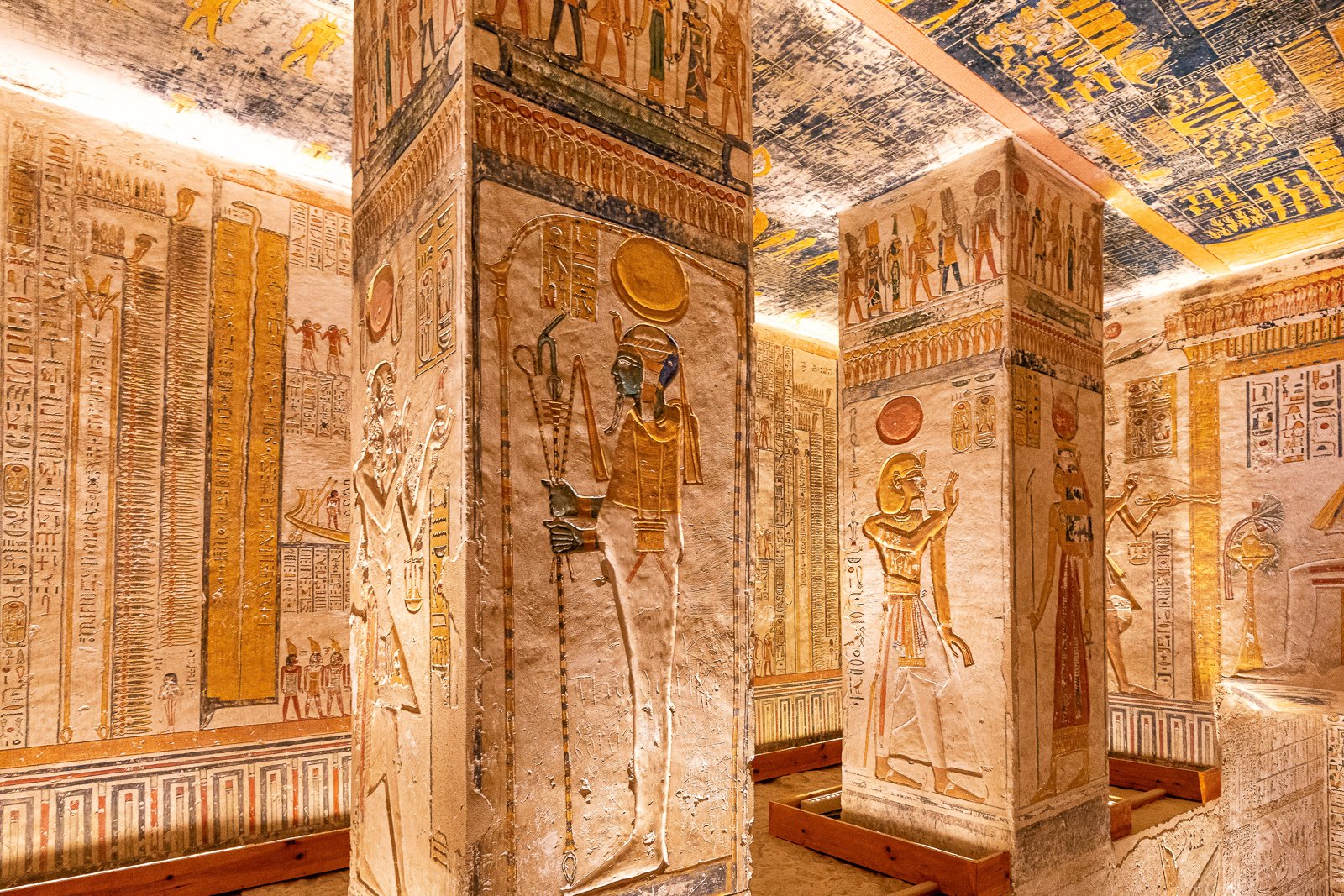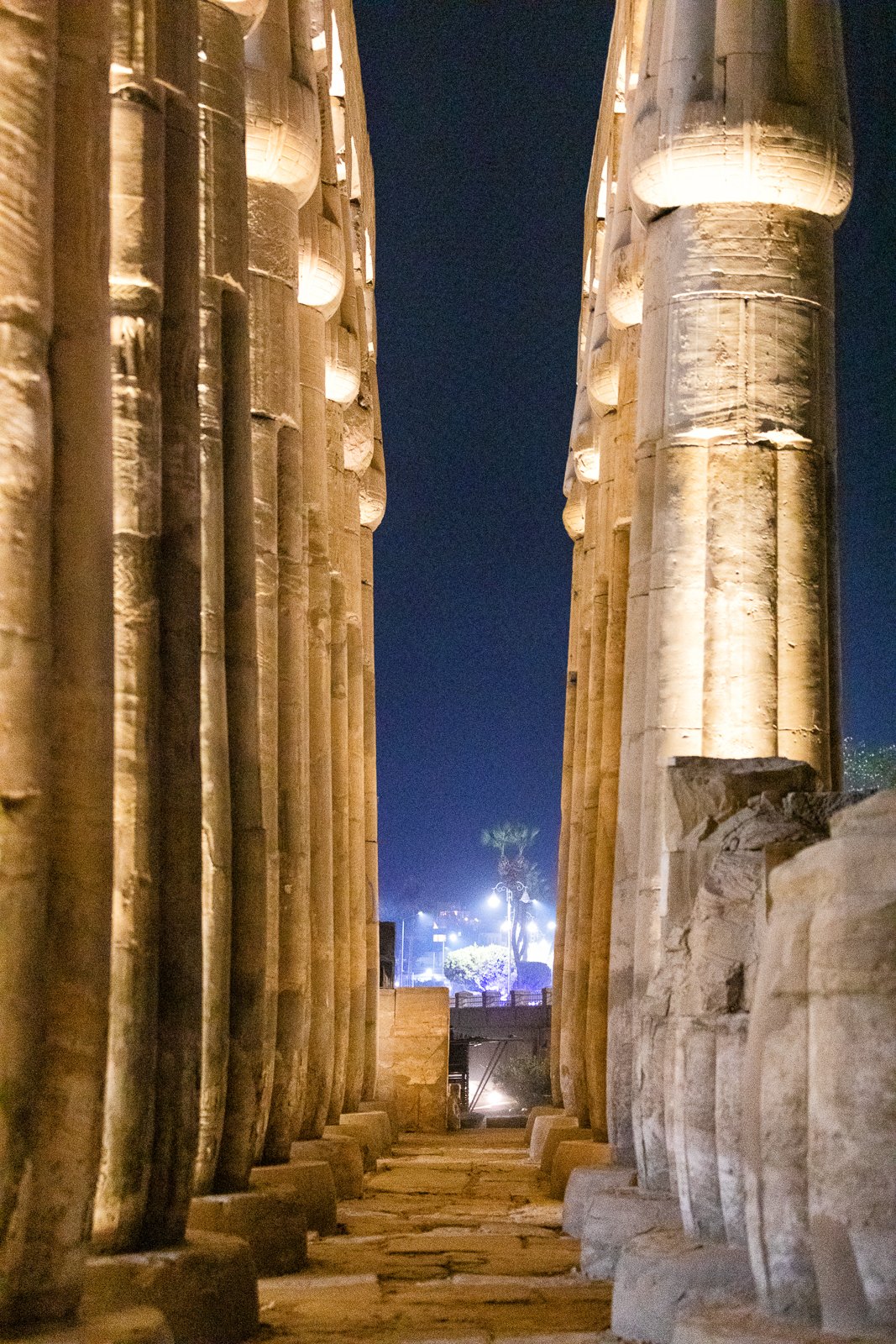Top 6 sights in Luxor, Egypt
Luxor, Egypt is the modern day town of Thebes. Thebes was the capital of Ancient Egypt from 1570 BC to 1069BC. Due to its location on the Nile River, it became a large city and had a population up to 80,000. Today, it is now an open air museum with lots of ancient temples and tombs for you to explore.
Valley of the Kings
Unless you are in the beginning stages of planning your trip, you no doubt have seen many photos of the Valley of the Kings and it is already on your list of things to do. For me, the Valley of the Kings was top on my list of things to see in Egypt. During the Old Kingdom, pyramids were built above ground however these were frequently raided and sometimes even parts of the pyramid themselves were torn. Pharaohs for 500 years from 16th century BC to 11th century BC (The New Kingdom) were buried here in tombs underground to help prevent raiding, unfortunately this was not the case. The most famous of which, is King Tut’s tomb, unique as it was left undisturbed and all the treasures remained until it was discovered in 1922. 65 different tombs have been discovered here. Although no more treasures remain in the tombs, the highlights are seeing all of the different hieroglyphics and artwork in the tombs. King Tut’s treasures are all on display at the Egyptian Museum in Cairo so today it also is empty.
Entrance Fee: 420 EGP is the base fee. there are other things to add on like going in specific tombs (like King Tut’s) or a photo pass if you want to take photos with a camera.
Hours: 0600-1700
Estimated time to explore: a minimum of half a day
Karnak Temple
The Karnak Temple is a massive temple and is second only to Angkor Wat in size for a religious complex. We spent several hours here and still did not have time to see everything. This is an open air temple with very little shade, I recommend going in the morning before it gets too hot. Despite there being multiple tour groups there, we were able to find areas where there was no one else. This temple was started in 2000 BC and was added on to over 2,000 years by over 30 different pharaohs. During the New Kingdom period, it represented not only a place of worship, but also the residence of the Pharoahs. It was dedicated to Amun-Ra, the sun god. Make sure to check out the two Obelisk. The main one is the Obelisk of Thutmose I which is 71 ft tall and is made from a single piece of red granite from Aswan. Should you go to Aswan, you can see a half carved obelisk that was abandoned after a crack was found. To the left of the main walkway there is an opportunity to get a photo of the two obelisks with a column in the middle.
Entrance Fee: 220 EGP
Hours: 0600-1700
Estimated Time to Explore: 3-4 Hours
Luxor Temple
Luxor Temple and Karnak Temple originally were connected with a 2 mile path, the Avenue of the Sphinxes. While it is now in disarray, you can see the start of the path prior to entering the temple. While most of the temples in Egypt you want to go to in the morning, this is one where you want to go at night. At night, the entire temple is lit up creating an amazing atmosphere. Luxor Temple construction started in 1392 BC and is dedicated to Amon, the king of the gods. It is thought that this was where the pharaohs were crowned. Multiple pharaohs contributed to the building of the temple as well as Alexander the Great.
Cost: 180 EGP
Hours: 0700-2000
Estimated Time to Explore: 2-3 Hours
Interesting fact: Luxor temple also has a lone obelisk as well. It used to be a pair, but the Egyptian government gave the obelisk to the French and it now stands at the Place de la Concorde. The second obelisk was also meant to go to France as well, but France renounced its claim. Some say it was a symbolic gesture, others say cause of the enormous cost to get the obelisk to France.
Sunrise Hot Air Balloon Ride
In Luxor, you have the opportunity to do a hot air balloon ride and it is a once in a lifetime opportunity to get to see Egypt from the sky. For us, it started witha pick up from our hotel and then a cruise across the Nile where a small breakfast was given. The pick up time is early, but it is one of the best things to do in Luxor so it was worth the early wake up call. We then got to go on the hot air balloon and see the Temple of Queen Hatshepsut and Colossi of Memnon from the air. You will get to fly over farmland and see the stark contrast of the bountiful land next to the Nile and the desert. It ended with a little dance party and then a ride back. There are several companies that do hot air balloon rides within Luxor. As a warning, you cannot take any large bags with you on the hot air balloon and most companies do not allow cameras. That being said, my guide told me you could put a smaller camera in a purse as long as it is not out at the beginning or end of the ride you should be fine. I did this and had no issue.
Cost: about $50 USD depending on the company
Temple of Queen Hatshepsut
Also known as Dier el-Bahari, it was built against a cliff. This temple is dedicated to Queen Hatshepsut, who is unique as she became a female pharaoh. Hatshepsut married her half-brother Thutmose II and became Queen Hatshepsut. After Thutmose II died, Queen Hatshepsut was appointed to rule until Thutmose III was old enough to rule. Thutmose III inherited the throne at the young age of 2. After several years of ruling the country, Queen Hatshepsut assumed role as a pharaoh alongside the co-ruler Thutmose III. After Hatshepsut died, Thutmose III and Amenhotep II tried to remove all accounts of her from Egyptian History and defaced her monuments. The Temple of Queen Hatshepsut was a mortuary temple that was built during her reign. It was defaced but subsequent pharaohs attempted to repair it.
Cost: 160 EGP
Hours: 0600-1700
Estimated time to explore: 2 hours
Colossi of Memnon
Our first introduction to the Colossi of Memnon was flying over them on a hot air balloon ride. The main thing to see here are the two statues of Amenhotep III that stand at 60ft high. They were built in 1350BC. Rumor is that these are the biggest tombs ever built, unfortunately due to earthquakes and floods all that remains are the statues. Today, there is not much left other than the statues so this stop should not take long.
Estimated time to explore: 15-30 min
Other guides you might be interested in:
What you need to know before you go to Egypt














